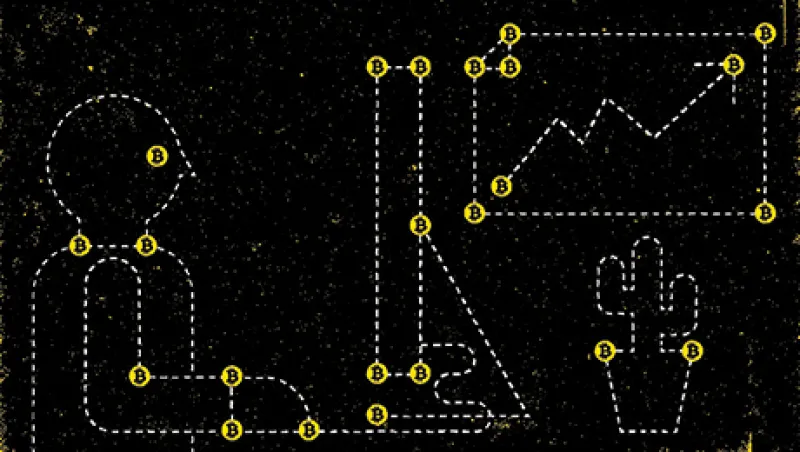In October several prominent figures in the Bitcoin development community launched a start-up to considerable fanfare in the technology and finance worlds. San Francisco–based Blockstream aims to take the encryption technology that Bitcoin is built upon — the blockchain — and improve it in ways that will, its founders say, “transform global systems of value exchange.” The company calls these improvements sidechains.
But ask Austin Hill, chief executive and co-founder of Blockstream, to explain — in less than one minute and using terms intelligible to a lay audience — what sidechains are and how they might help institutional finance, and he launches into a meandering answer that begins, “I think the analogy that’s been used is the TCP/IP and routing infrastructure that existed before the consumer Internet.” By the time he has finished, six minutes later, he has dropped in unexplained references to “hash power,” the blockchain’s “hash rate,” “industrial mining centers” and “the SHA-256 algorithm” before concluding with a brief digression on how 98 percent of developers of alt.coins, or alternative, Bitcoin-like cryptocurrencies, are “attempting to pump and dump an asset class.” This, Hill says, confirms that there is a “Wolf of Wall Street–style dynamic at work in much of the Bitcoin world,” referencing Martin Scorsese’s 2013 film about a corrupt stockbroker.
Bitcoin is regularly accused of having both a complexity problem and a hype problem. Skeptics contend it’s too complicated for the ordinary person to understand, much less use, so it will never gain traction beyond a computer programming–savvy minority. This, in turn, means the alternative currency is perennially overhyped. Like the old joke about Brazil, critics say Bitcoin is the currency of the future — and always will be. On the evidence of Hill’s answer, the blockchain looks likely to inherit some of these problems, especially when it comes to complexity.
But will that even matter? The developers at the vanguard of Bitcoin’s brave new era are confident it won’t. In their view, the blockchain makes it possible to create an Internet of value. These opportunities to “introduce massive savings and remake entire fortunes and create new types of companies are going to draw a huge amount of innovators who just see a better way of doing things,” asserts Hill.
The blockchain is a distributed public ledger of transactions, made possible by advances in cryptography, game theory and peer-to-peer networking; the last allows for the transfer of any unit of value in an entirely decentralized way, without intermediaries such as banks. It’s a trustless system in the sense that users don’t need to rely on a third party to process a transaction. To date, the blockchain has been used as a way to move one particular type of asset around the world: Bitcoins. Blockstream’s founders are betting that the blockchain will be far more interesting and powerful as a technology once it is applied to the myriad other assets in circulation, especially digital ones such as financial securities.
They’re not the only ones making the argument. CoinDesk, a London-based Bitcoin data firm, estimates that the digital currency has received almost $340 million in venture capital investment since its birth five years ago. Most of that has gone to projects focused on payments and currency, but many members of the cryptocurrency community now believe that Bitcoin proper will be left behind as developers focus on applying the underlying technology to new areas.
“The steam engine was a great breakthrough, but it took quite a few years to get to the optimal steam engine,” says Dave Birch, an analyst at Consult Hyperion, a Surrey, England–based electronic transactions consulting firm, who is one of the global cryptocurrency community’s leading thinkers. The future of Bitcoin may not be Bitcoin at all.
Sidechains, Hill says, will accelerate the pace of innovation in Bitcoin’s underlying infrastructure. In a post on LinkedIn published at about the same time as Blockstream’s launch, Reid Hoffman, a partner at Menlo Park, California–based venture capital firm Greylock Partners, wrote that these improvements will eventually turn the blockchain into “the kind of open, highly adaptive platform upon which a vast array of complementary products and services can be built.” Hoffman was one of nearly 40 investors to contribute to Blockstream’s seed round, which attracted a string of high-profile backers — including Google chairman Eric Schmidt’s Innovation Endeavors and Yahoo co-founder Jerry Yang’s AME Cloud Ventures — and raised $21 million by the time of its close in mid-November. Blockstream’s success, Hoffman predicted, “will in turn generate new waves of technical and entrepreneurial innovation.” Like many of Blockstream’s 11 founders, Hill, a technology industry veteran, has a long-standing member with Bitcoin’s core development team, a loose central community responsible for keeping the cryptocurrency’s programming house in order.
Once the blockchain is enhanced, developers will come in and build ... well, what exactly? This is where things become less clear. The idea that most excites Hill and others in the Bitcoin community is the possibility of using the blockchain to eliminate the cost and time of clearing and settling financial assets, which even today require two to three days of posttrade processing. “That is a legitimate objective right now,” says analyst Birch.
But beyond that the potential product road map gets muddled. Hill speaks of reconfiguring protocols widely used in the capital markets, such as SWIFT (for messaging) and FIX (for trading), to run off the blockchain. He also sees a use for the technology in allowing exchanges, clearinghouses and other financial intermediaries to perform their functions in a way that creates liquidity and increases efficiency without requiring those institutions to warehouse actual assets, which will sit instead on the distributed blockchain. This, Hill asserts, will reduce systemic risk.
Others are big on the idea of using the blockchain to enable real-time auditing of financial transactions, to prevent fraud and malpractice: In theory, it will eventually be possible to cryptographically encode a reinsurance agreement, for instance, to make certain it doesn’t exceed regulatory leverage ratios, or to build a chain of transparency across the entire asset web underlying a complex derivative.
The question of what happens to the institutions on Wall Street in a blockchained universe is less certain. “Some intermediaries are going to get replaced by blockchains completely, but others will still have a role,” predicts Vitalik Buterin, a 20-year-old hacker who one year ago founded Ethereum, a Zug, Switzerland–based nonprofit organization also developing noncurrency applications of the blockchain. Hill provides a similarly elliptical prognosis. “The whole system can start to be rethought and rearchitected in some pretty interesting ways,” he says, adding that it will be a half decade or more before these changes start to take shape.
Financial institutions may gain or lose from the advent of the blockchain — at this stage it’s difficult to tell. But even though Wall Street today is a complex network of interlocking relationships and embedded interests, companies like Blockstream and Ethereum believe they will help force a tectonic reshaping of the industry. The U.S. government tried something similar with the Dodd-Frank Wall Street Reform and Consumer Protection Act, and its efforts have met with fierce resistance and only partial success. What makes blockchain developers think they will succeed where Washington’s lawmakers, acting with the legitimacy of government and the mandate of a financial crisis behind them, have found the going so tough? “The answer becomes one of innovation, network effects and self-interest,” Hill says. This is a variation on an old idea: If the blockchain is built, the innovators will come. Eventually, incumbent financial institutions will be forced to adapt or perish, the logic goes.
Today much of the thinking about the blockchain’s applications to institutional finance remains grandiose and undetailed — perhaps understandably given the technology’s early stage of development. Much of it presupposes that blockchain-based applications will be simple and trustworthy enough for investors to use with confidence. That’s still a moot point, even though Hill contends that Blockstream already has a diverse stable of clients interested in its technology, from national governments that are exploring issuing their fiat currencies on the blockchain to gaming companies that want to use the blockchain as the basis for value systems in virtual reality. Bitcoin, meanwhile, has seen its price fluctuate wildly since its birth in 2009. The alternative currency spiked above $1,100 in November 2013 before losing half that value in the month that followed; there have been wild swings in the year since, with a single Bitcoin now trading at about $350. The aggregate value of all Bitcoins in circulation today is close to $5 billion.
The way Hill paints it, the development of sidechains will avoid much of the fuss over complexity and volatility that has bedeviled the growth of Bitcoin. This is because sidechains, by their very nature, are complex things to build; at their essence they are incremental additions to the blockchain that allow individual blocks to connect to one another and on which useful products can be built. It doesn’t matter that this process is hard to understand.
“It’s kind of like the difference between Cisco and Google,” Hill explains. “It’s like the growth of the Internet. You needed the infrastructure before the applications on top could make any sense.”
Blockstream’s objective is to provide the architecture for innovation to flourish — not to do all the innovating and build all the products itself. Ordinary consumers won’t need to understand sidechains or the blockchain or how they function, because the applications they eventually will engage with will conceal the underlying infrastructure. The early concern over Bitcoin’s complexity will fade, the argument goes, as the universe of user-friendly, consumer-facing applications grows.
Bitcoin is already developing in that direction, with companies such as Coinbase and Circle building web-based Bitcoin wallets that remove the need for users to be tech experts to be able to transact in cryptocurrency. But these technologies come with a catch: They introduce a new level of intermediation and trust into a system previously thought to be trustless. All of a sudden, users have to rely on a third party to take care of their assets, thereby defeating the initial purpose of the blockchain. Hill asserts that Blockstream will avoid that problem by allowing user-friendly products to develop “without giving up the power of distributed trust and security.” Quite how that will happen remains to be seen.
In the meantime, companies looking to build on the promise of the blockchain will have to find ways to refute the bad press that sticks to Bitcoin. The cryptocurrency’s boosters like to trumpet that because they’re decentralized and freed of dependence on third parties, transactions on their network avoid the types of credit and liquidity risks that haunt banks. Critics contend that the lack of a controlling third party means the blockchain is vulnerable to attack. Hill’s response is that the processing power needed to add and verify transactions on the blockchain is so great that it would require an investment of $800 million to $1 billion, with massive and unprecedented access to global semiconductor supply, to be able to build the hardware needed to generate the computational resources required to effectively bring down the blockchain. “There’s no practical possibility for a bunch of Eastern European or Russian cyberhackers to be able to attack the blockchain,” Hill says, not making it clear why he’s singling out cyberhackers of those specific nationalities.
This points to a related problem. Bitcoin’s recent associations with Silk Road, the now-shuttered online emporium for hard-drug transactions, and Mt. Gox, the Bitcoin exchange that collapsed earlier this year, have fed the perception that the cryptocurrency world is a hotbed of fraud and lawlessness. “There’s a noisy minority, which has an angry white male libertarianism at its core, that doesn’t represent the wider interest from the financial community in this technology,” Consult Hyperion’s Birch asserts. But that minority can be difficult to ignore, and its influence stretches deeper into the community than many of Bitcoin’s more business-friendly backers might like to admit. Earlier this year Amir Taaki, a hacker and anarchist who is the Bitcoin world’s reigning enfant terrible, boasted that his Dark Wallet product, a Bitcoin wallet designed to obfuscate users’ identities, was a scheme to facilitate money laundering. Taaki developed Dark Wallet in conjunction with Cody Wilson, a fellow 26-year-old, who came to public prominence in 2013 as the developer of the world’s first 3-D printed gun.
Ethereum has taken a more radical approach than Blockstream to building out its offering. Buterin and his team of 40 developers have created a whole programming language from scratch, and their objective is to build a new alternative blockchain rather than provide incremental improvements to the existing Bitcoin blockchain, as Blockstream is attempting. Buterin, who quit pursuing a computer science degree at Ontario’s University of Waterloo after eight months, at age 18, to devote himself full-time to the Bitcoin cause, lived with Taaki for “a bit over a month” and says “he’s quite a funny guy.” In the Bitcoin world sympathy for the proto-anarchist, antigovernment stance is never far from the surface of any conversation. Developments in the emerging blockchain world appear set to replicate that dynamic.
Anyone old enough to recall the look and feel of a standard GeoCities web page will remember that the early Internet was a messy, quirky, unconventional place. What’s most interesting about the Bitcoin world right now is the way that its three main communities — technologists, politically engaged “hacktivists,” and businesspeople and investors such as Hoffman — are each jockeying for position and influence over the direction of the greater Bitcoin story. Today, Bitcoin is probably still seen by most people as the province of kooks and utopians; in its life cycle it’s at something like a GeoCities stage of development. Figures like Taaki remain engaged in the spirit of political adventurism that characterized much of Bitcoin’s early development. But if entrepreneurs and investors like Hill and Hoffman have their way, Bitcoin and the blockchain are set to become the platform for a much more directly commercial wave of innovation. That vision is still in the distance, and its outlines are relatively blurry. The promise of blockchain technology may be every bit as immense as its supporters contend, but it will be some time yet before Bitcoin grows up and gets serious.
Get more on trading and technology.
Follow Aaron Timms on Twitter at @aarontimms.







